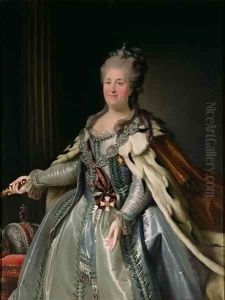Anton Albertrandi Paintings
Anton Albertrandi, born in 1731 in Warsaw, Poland, was an 18th-century Italian painter who spent much of his career in Poland. Although not as widely recognized as some of his contemporaries, Albertrandi contributed significantly to the artistic landscape of Poland during his time.
Albertrandi's early life is not well documented, but it is known that he received his artistic training in Italy, which was the center of the art world during the 18th century. He was likely influenced by the Baroque style, which was prevalent during his formative years as an artist. His work later evolved to incorporate elements of the Rococo style, which became popular in the latter part of the 18th century.
In the mid-18th century, Albertrandi moved to Poland, where he became a court painter. This was a prestigious position that allowed him to create portraits and religious compositions for Polish nobility and the clergy. His work was characterized by its fine detail, vibrant color palette, and the elegant portrayal of his subjects. Albertrandi's paintings often depicted the wealth and status of his patrons, a common practice among court painters of the time.
One of Albertrandi's most significant contributions to Polish art was his influence on the development of portrait painting in the country. He brought Italian techniques and a sense of sophistication that was previously less common in Polish portraiture. His portraits are notable for their psychological depth and the nuanced expressions of his subjects.
Despite his success, little is known about Albertrandi's personal life, and many of his works have been lost or remain unidentified. However, those that survive are held in high esteem and can be found in various museums and private collections, particularly in Poland.
Anton Albertrandi passed away in 1809. Although he may not be a household name, his work remains an important part of the artistic heritage of Poland, bridging the Italian and Polish art worlds of the 18th century.
